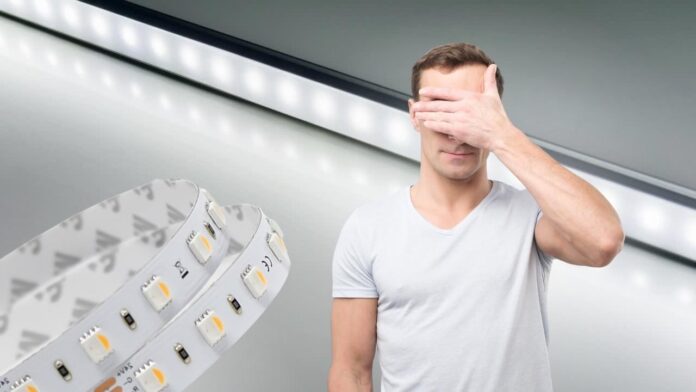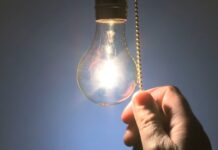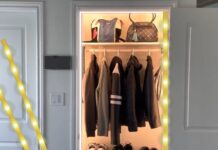Are Led Strip Lights Bad For Your Eyes? This is a question that has been asked by many people, and the answer is not a simple one. if you are considering installing LED strip lights in your home or office, read on for some important information.
In this blog post, we will explore different types of LED lights that can be bad for your eyesight and we provide you provide some tips on how to reduce any possible eye strain. Keep reading to learn more!
What Types Of Led Lights Bad For Eyes:
1. Flickering Lights:
Flicker rate is the number of times per second that an LED light can change its brightness. A flickering light can cause eye strain, headaches, and migraines.
2. Blue Light:
Blue light has a shorter wavelength than other colors and penetrates deep into the eye. Exposure to blue light can damage the retina and lead to macular degeneration.
3. Bright Lights:
Bright lights can cause glare and affect your vision. too much exposure to bright light can also damage your retina.
4. UV Light:
UV light is invisible to the naked eye but can be harmful to the retina. Prolonged exposure to UV light can cause macular degeneration, cataracts, and other eye problems.
5. Infrared Light:
Infrared light is invisible to the naked eye but can cause damage to the retina. Exposure to infrared light can lead to macular degeneration and other eye problems.
please also check: Best Outdoor Gooseneck Barn Lights
Are Led Strip Lights Bad For Your Eyes:
Many people are worried about are LED strip lights bad for the eyes, While there is some evidence that too much exposure to blue light can be harmful, there is no evidence that LEDs are any worse for your eyes than other types of lights.
In fact, LEDs strip lights may even be easier on your eyes because they don’t flicker like some other types of lights. So if you’re concerned about the potential effects of LED strip lights on your eyes, there’s no need to worry.
How To Reduce Eye Strain Cause By Led Lights:
If you’re looking for ways to reduce eye strain caused by LED lights, there are a few things you can do.
1. Use Dimmer Switch:
Dimmer switches can be used to reduce the brightness of LED lights. This can help to reduce eye strain and make it easier to fall asleep after being in a well-lit room. and also make it more comfortable to stay in a well-lit room for a longer period of time.
2. Take Breaks:
Taking breaks from looking at screens and other bright lights can help to reduce eye strain. It’s important to give your eyes a rest every 20 minutes or so to prevent fatigue.
3. Adjust Lighting:
Adjusting the lighting in your home or office can help to reduce eye strain. If possible, try to avoid working in a completely dark room or under bright fluorescent lights. instead, adjust the light level until it’s comfortable for your eyes.
4. Use Anti-Glare Screens:
If you work with computers or other electronic devices, using an anti-glare screen can help to reduce eye strain. These screens reflect some of the light away from your eyes, making it easier to see the screen.
5. Wear Sunglasses:
Wearing sunglasses outdoors can help to reduce eye strain by blocking out bright sunlight. Sunglasses with blue-light filtering lenses can also help to reduce eye strain caused by LED lights.
6. Blink More:
Blinking helps to keep your eyes lubricated and can help to reduce eye strain. If you find yourself blinking less often, try to blink more consciously or use artificial tears to keep your eyes moist.
7. Use The Right Lighting:
If you’re working in a well-lit room, using the right type of lighting can help to reduce eye strain. LEDs are a good option because they emit little to no UV light and don’t flicker like some other types of lights.
8. Take A Supplement:
If you’re exposed to blue light for long periods of time, taking a supplement that contains zeaxanthin supplements can help to protect your eyes. Zeaxanthin is a type of antioxidant that helps to filter out blue light and reduce eye strain.
Conclusion:
LED strip lights are a popular choice for many homes and businesses, but there is some concern that led strip lights may be bad for your eyes. We’ve taken a look at the research on this topic and want to share what we’ve found with you.
But there are a few things to keep in mind if you decide to use them. First, make sure the light is not too bright – aim for around 120-130 lumens per square foot. Second, take breaks from looking at the light every 20-30 minutes. Overall, it seems that LED strip lights are safe for most people
FAQs:
1. Can RGB lights damage your eyes?
Answer: RGB lights can be damaging to your eyes, but only if you stare directly into them for an extended period of time. Most LED lights have a built-in safety feature that prevents you from looking directly into them for too long So it is always best to avoid looking directly into the light sources.
2. Are led strip lights bad for your skin?
Answer: It is possible that led strip lights can be bad for your skin, depending on the length of time you are exposed to them and the intensity of the light. The light emitted by led strip lights is primarily in the blue-violet range, which can be damaging to skin cells.
3 . Are led lights bad for health?
Answer: A study released in 2019 found that blue-light emitting LEDs could increase the risk for age-related macular degeneration, while other studies have linked light exposure to increased risk for neurological problems like headaches and sleep disorders.
4. Do LED strip lights give off radiation?
Answer: There is a small amount of radiation given off by LED strip lights, but it is far less than the radiation emitted by other traditional light sources like incandescent and fluorescent lights. LED strip light that is six feet long will give off approximately the same amount of radiation as a cell phone.




